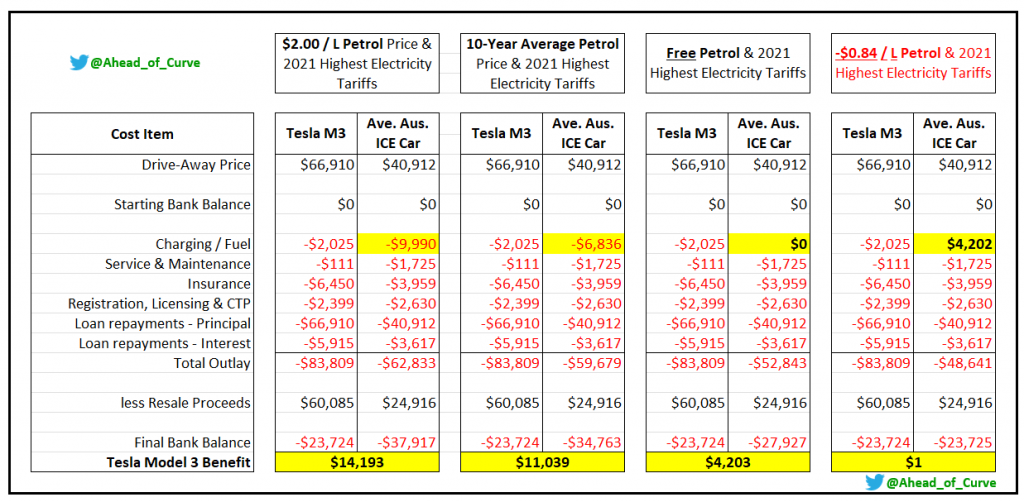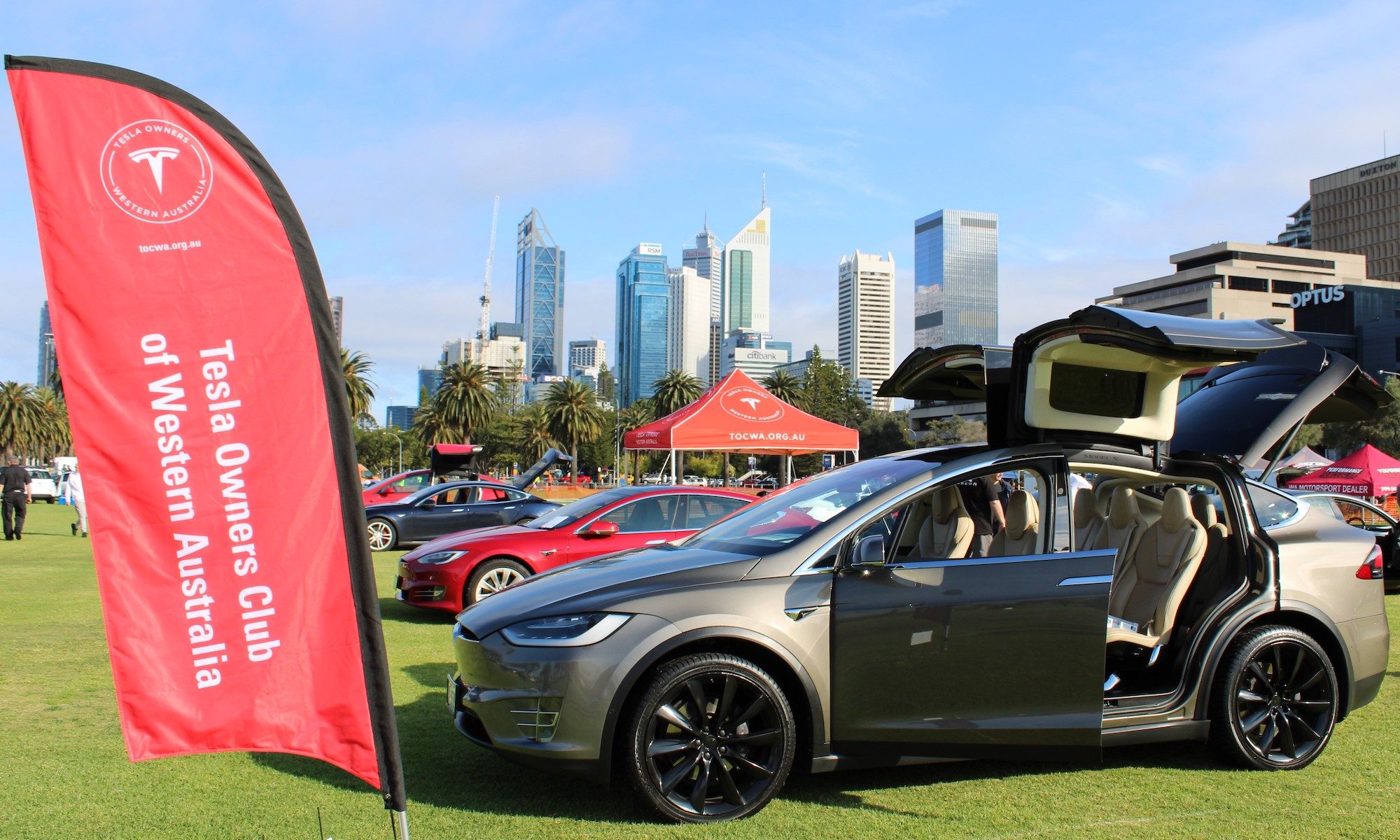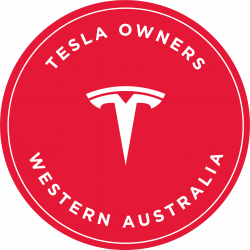
With petrol and diesel prices at the pump rising to astronomic levels are you thinking of switching to an electric vehicle?
If so, you’re not alone. As can be seen from the Google Trends search data below, Australians are increasingly thinking about making the switch to EVs.

There is a long list of reasons to switch to an EV but if it’s the cost of owning and running a car that’s your main motivator, you’ll want to know how the figures compare to your current car and you’ll also be interested to know how this may change as petrol prices rise or fall.
The chart below illustrates the relationship between fuel prices and how much better off you are likely to be, owning what is by far Australia’s most popular EV, a Tesla Model 3 versus owning an average Australian internal combustion engine (ICE) car. The calculations are based on a short 3-year period of ownership but the longer you hold on to the Model 3 the better off you’ll be.

As the chart above shows, at a petrol price of $2.00 per litre, you’ll be at least $14,193 better off with the Model 3 after 3 years, but even if the petrol price was to halve to $1.00 a litre you would still be $9,198 in front. Incredibly, even if fuel was completely free, the Model 3 would still put you in front to the tune of $4,203 over 3 years. In fact, the petrol price would need to be at a negative 84 cents for you to be at break-even point. Yes, you read that correctly, the petrol station would need to pay you $84 for every 100 litres of fuel you pump into your car and owning the Model 3 for just three years would still put you a dollar in front.
In case you’re wondering what is the affect of the cut in the fuel excise tax announced in the federal budget on 29th of March, it would work out to $1,099 over a 3-year period but the Treasurer has announced it will only be put in place for 6 months, so it works out to about $183. Therefore, the difference is a benefit of $14,093 vs a benefit of $13,910 for the M3 over an ICE car, but that of course assumes that fuel prices don’t go up any further.

The table above provides some insight into the calculations which are based on Australian averages and if anything, are a little too kind towards the petrol car. For example, it assumes that the Tesla Model 3 is charged from the electricity grid 100% at average standard electricity tariffs. Once you purchase an EV, you’ll quickly realise there are various EV-friendly lower cost tariffs offered by electricity retailers. Furthermore, most EV owners charge their cars using a solar PV system which, can produce more than enough power to cover the electricity usage of an average Model 3 several times over. For example, assuming a typical residential system with a 6.6kW solar panel array and a 5kW inverter, one would expect it to produce anywhere from 23-24kWh a day in the least sunny parts of Australia such as in Melbourne or Hobart to around 26kWh in Sydney, 28kWh in Adelaide or Brisbane or about 29kWh a day in Australia’s sunniest cities like Perth or Darwin. A Model 3 driving the average amount driven by an Australian car will use between 6 and 6.5kWh a day. Therefore, a typical residential solar system in Perth will produce enough free energy to power four and a half Model 3s and even in Melbourne a typical solar PV system will power about 3.75 M3s leaving surplus energy for another EV and the rest of the home.
The great benefit of solar power is its predictable cost. With the cost of petrol and diesel being based on fluctuating prices determined by world oil markets, it’s anyone’s guess what the prices may be at the bowser in the next few weeks let alone in the next few years, making household or business budgeting a challenge. In contrast, once an appropriately designed solar PV system has paid for itself, usually in about two to five years, the price of its solar generated electricity is exactly zero as the power it generates comes from the sun which has cost the exact same amount of zero cents for the last 4.603 billion years and will likely cost the same for a further 5-7 billion years. (Some will argue that there is an opportunity cost in the form of foregone feed-in-tariffs, however, these have been declining over the years and they generally represent only about a quarter of a standard residential electricity tariff.)
While it’s hard to argue with the economics of owning Australia’s most popular electric vehicle, there are many other important aspects of car ownership. I would argue that when it comes to an EV such as the Model 3 or Model Y, there are only two factors that one could argue to be inferior to a petrol car. These are the upfront cost in the form of the sticker price and the time to refuel, however, as you will see these are largely irrelevant in the vast majority of situations for most Aussie car owners.
As I hope I have made evident in the first part of this article, it doesn’t make financial or any other sense to look at a car’s sticker price in isolation. One should take all the costs of car ownership into account and make decisions based on the difference in the total cost of ownership because if you don’t you could fall into the trap of buying a $50 printer only to later realise the print cartridges will cost you $100 each. With that said, the only time the sticker price becomes relevant is if one is unable to stretch the budget or the loan. While I would never advocate for anyone buying a car they can’t afford, there is a phenomenon called the “Tesla Stretch” where aspiring Tesla owners have stretched their budgets and / or borrowing capacity to afford their dream car. The Tesla Owners Club of Western Australia (TOCWA) conducted a recent poll on its Facebook page which which showed that almost 88% of the 139 respondents spent more on their Tesla than on their previous car with a staggering 69% paying $30,000 or more.


As with the sticker price, the time to refuel argument is only relevant in rare circumstances. With a highway range of approximately 350 – 400km the Tesla Model 3 RWD has the shortest range of any Tesla but even with this model the time to refuel will only be a factor on long road trips with legs of more than three and a half to four hours at a time. It should be noted that to avoid driver fatigue the recommendation is to have a 15-minute break at least every two hours. At all other times, an EV is actually much more convenient than a petrol or diesel vehicle because, similar to a smartphone, you recharge it when you’re at home which means that most of the time you hop in the Tesla you’ll have about 10 days of driving waiting and ready to go without the inconvenience of spending time searching for and driving to a reasonably priced service station, then standing there with your hand on the bowser inhaling the petrol fumes for five minutes, then lining up to pay and so on.

Having focused on the two factors where one could argue than an EV is inferior to an ICE car, below is a list of some of the other factors where Australia’s most popular EV excels including:
- Safety
- Driver-Assistance Features
- Performance
- Functionality
- Connectivity
- Storage space
- Environment
- Security
- Convenience
- Entertainment
- Practicality
- Technology
- Australian made content
- Brand / Mission
- Easter Eggs and numerous other features unique to a Tesla

Furthermore, unlike most cars which are the best they will ever be the day they are driven off the dealership lot, the Model 3 continually improves via mostly free over-the-air (OTA) software updates.
Does this mean that a Model 3 or a Tesla for that matter is the right EV or even the right car for everyone and for every situation? No, of course not, but it’s hard to deny that it presents a very compelling proposition and once Full Self-Driving (FSD) becomes a reality in the not-too-distant future, driving anything other than a Tesla may as Elon Musk explained feel like riding a horse. Furthermore, with there being no end in sight to the volatility in fuel prices Elon may have also have been right when he said that it would be “financially insane to buy anything other than a Tesla”.
(This article was first published on 26th of March. It was edited on 29th of March with the only change made being the insertion of the paragraph above the saving table relating to the fuel excise cut.)

Pete Petrovsky is an active TOCWA (Tesla Owners Club of Western Australia) committee member and a long-time EV enthusiast. He placed a $6,000 deposit for a Model X (#39) in 2014 but when it came to taking delivery he couldn’t justify the cost, so instead, he and his wife decided to buy two PHEVs and wait for the Model 3. In March of 2016 they bought the Holden Volt and a couple of weeks later the Mitsubishi Outlander PHEV, and on the day it was unveiled, Pete ordered the Model 3. After selling the Outlander, in September 2019, Pete received his long awaited first Tesla, a Model 3 Performance. Despite still loving their Volt, Pete and his wife took delivery of their second Model 3 in December 2021. In his spare time, Pete also runs the ‘Tesla Ahead of the Curve’ YouTube channel and is also a long-term Tesla shareholder.


One Reply to “Fuel prices are fuelling the switch to electric vehicles, but will an EV still be worth it if fuel prices drop?”